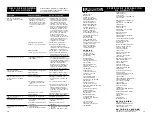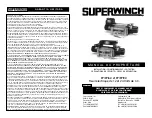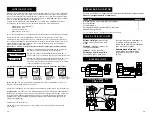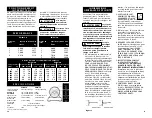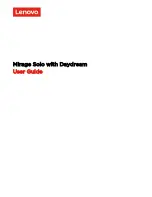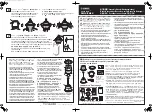
6. EQUIPPING THE WINCH WITH A
ROLLER FAIRLEAD will substantially
reduce wear on the wire rope
during angle pulls (Figure 11).
The rollers eliminate heavy rubbing
and abrasion to the wire rope.
Periodically check tightness of
mounting bolts and electrical con-
nections. Remove any dirt or corro-
sion that may have accumulated on
the electrical connections.
Repairs should be done by
Authorized Superwinch Repair
Centers ONLY. Do not attempt to
disassemble the gearbox.
Disassembly will void warranty.
LUBRICATION
The gearbox and drum bearing are
permanently lubricated with a high
performance gear lube.
REPLACING THE WIRE ROPE
Never substitute a heavier or lighter
wire rope. Never use rope made of
any other material other than wire.
Always use wire rope with a mini-
mum breaking strength of 10,800
lbs. (48kN).
Always replace damaged wire
rope with manufacturer’s
identical replacement part
(see
Replacement Parts list). Pass attaching
end of wire rope through the fairlead (if
equipped) and attach it to the drum.
When inserting the wire rope into
the drum, insert it into the correct
end of the hole provided (Figure
12). Tighten the set screw securely.
It is important that the wire rope
be wound tightly onto the drum.
A good way to do this is to attach
the wire rope hook to a fixed object
at the top of a slight incline, then
winch the vehicle up the incline.
When wire rope is removed from
the drum, as in bringing the hook
to the load, the freewheel feature
of the winch should be used.
BRAKE OPERATION
Your winch incorporates a propor-
tional friction-type brake. After
winching in a load, this mechanism
holds the load, up to the rated
capacity of the winch. While power-
ing-out a load, the winch controls
the rate of speed by applying the
brake in proportion to the amount
of the load on the winch cable. This
results in heavier loads powering-
out more slowly than lighter loads.
Similar to the friction-type brakes in
your automobile which can gener-
ate heat if used for a long period of
time, the winch brake can generate-
heat if used to power-out a load for
a long period of time.
To ensure
optimum winch perfromance,
always limit powering-out of a
load to 2 minutes and allow the
brake to cool for 15 minutes
before continuing to winch.
Under normal use, the brake mech-
anism should not require any adjust-
ment. Should the brake fail to hold
a load or maintain a constant rate
of speed during power-out opera-
tion, the brake pad may be worn
and require replacement.
After extended
periods of pow-
ering-out loads against the brake,
the gearbox housing may become
hot.
PULLING OUT THE WIRE ROPE
The wire rope has been installed on your
winch under minimal load at the factory.
The wire rope must be respooled onto the
drum under load so that the outer layers
will not draw down into the inner ones
thereby damaging the wire rope.
1. Rotate the clutch lever to the
“Disengaged” position as shown
in Figure 8. If there is a load on
the wire rope, the clutch lever
may not turn easily. DO NOT
FORCE THE CLUTCH LEVER.
Release tension on the wire
rope by jogging out some of
the wire rope, then try releasing
the clutch.
2. Pull out the wire rope and
secure to anchor or load.
3. Check that there are at least
five (5) turns of wire rope left on
the drum.
4. Re-engage the drum by rotating
the clutch lever to the “Engaged”
position (see Figure 8).
Lever must be in
the engaged posi-
tion and locked before winching.
TIPS FOR EXTENDING THE LIFE OF
THE WINCH
1. KEEP A TIGHTLY WOUND WIRE ROPE
DRUM. Do not allow the wire rope to
become loosely wound. A loosely-
wound drum allows a wire rope under
load to work its way down into the lay-
ers of wire rope on the drum. When this
happens, the wire rope may become
wedged within the body of the wind-
ings damaging the wire rope. To prevent
this problem, keep the wire rope tightly
and evenly wound on the drum at all
times. A good practice is to rewind the
wire rope under tension after each use.
One way to do this is to attach the hook
to a stationary object at the top of a
gradual incline and winch your vehicle
up the incline.
2. DO NOT ALLOW WINCH MOTOR TO
OVERHEAT. Remember, the winch is for
intermittent use only. During long or
heavy pulls the motor will get hot. The
internal parts will be hotter than the
case. To check the motor temperature,
stop winching and carefully touch the
motor case, if the motor is uncomfort-
able to touch, allow the motor to cool
before continuing. KEEP THE ENGINE
RUNNING TO RECHARGE THE BATTERY
during this break.
3. To maximize winch and wire rope life,
use a pulley block to double line heavier
loads (Figure 9).
4. The pull required to start a load moving
is often much greater than the pull
required to keep it moving. AVOID
FREQUENT STOPPING AND STARTING
during pull.
5. PREVENT KINKS BEFORE THEY OCCUR.
(FIGURE 10).
CAUTION
!
10
11
Figure 10
a
b
c
a
. This is the start
of a kink. Wire
rope should be
straightened.
b
. Wire rope was
pulled and loop
has tightened into
a kink.
Wire rope
is now perma-
nently damaged
and must be
replaced.
c
. Result of kink-
ing is that each
strand pulls a dif-
ferent amount caus-
ing strands under
greatest tension
to break and
reduce load capac-
ity of wire rope.
The wire rope
must be
replaced.
Figure 11
M A I N T E N A N C E
Figure 12
Figure 8
Figure 9
Engaged
Disengaged
WARNING
!
Summary of Contents for EP/EPi6.0
Page 28: ...54 55 N O T E S N O T E S...


















